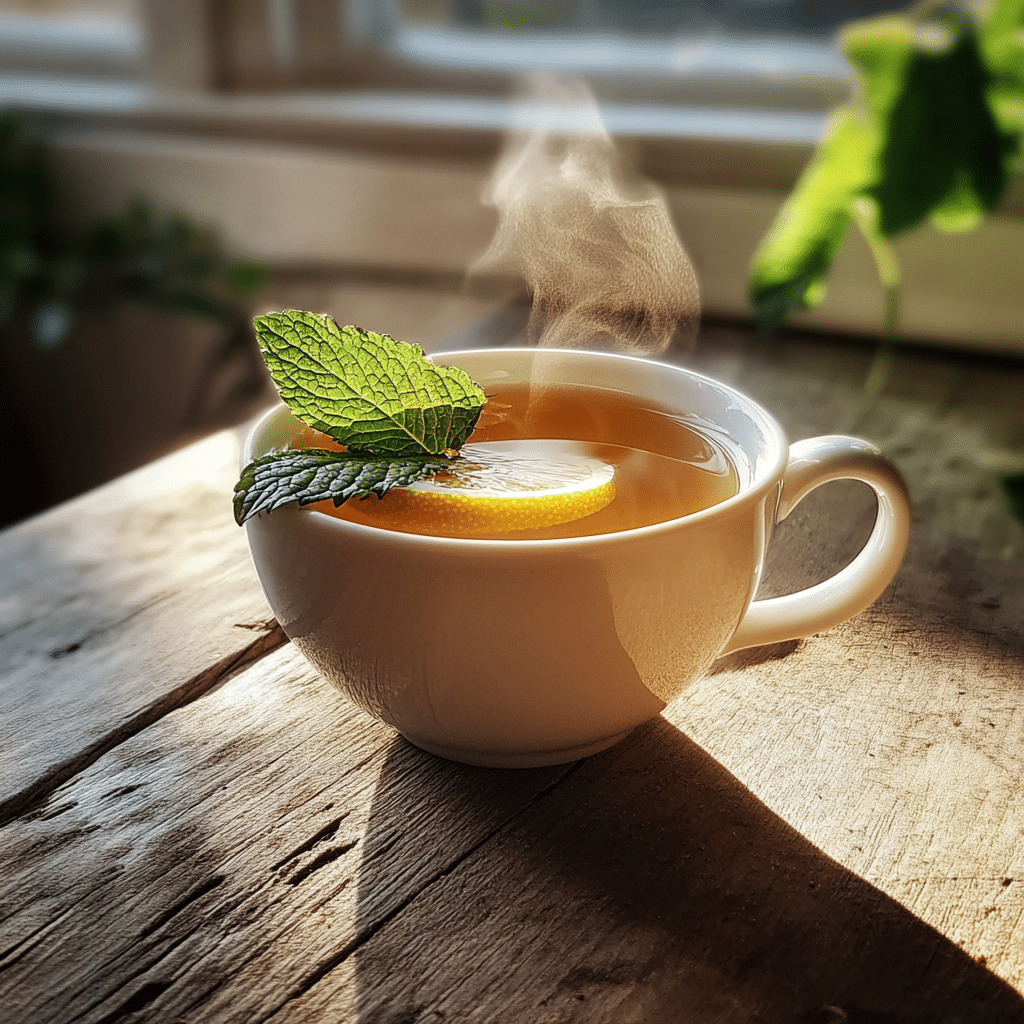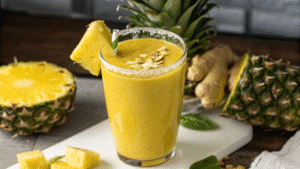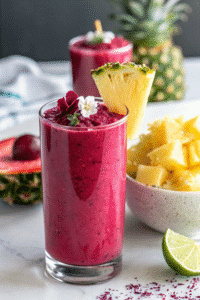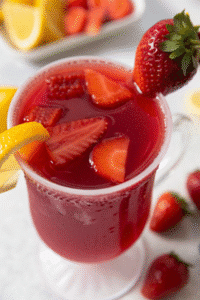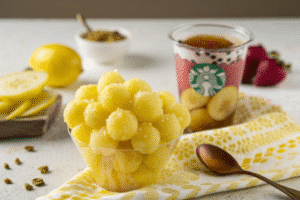Looking for a gentle, relaxing herbal tea that tastes just as good as it feels? This lemon balm tea recipe might be exactly what you need. Lemon balm tea recipe, a fragrant herb from the mint family, has been used for centuries for its calming properties. Whether you’re feeling stressed, struggling with sleep, or just want a naturally caffeine-free tea to sip on any time of day—this recipe delivers.
In this article, you’ll learn how to make lemon balm tea recipe from scratch, explore its health benefits, discover different ways to customize it, and understand who might need to be cautious when drinking it regularly. You’ll also find answers to common questions like whether it’s safe to drink on an empty stomach or if dried lemon balm tea recipe works as well as fresh.
Don’t miss our Cottage Cheese Banana Bread for a perfect tea-time pairing.
Table of Contents
ToggleLemon Balm Tea Recipe
What Is Lemon Balm Tea Recipe and Why It’s Popular
Lemon balm (Melissa officinalis) is a fragrant herb with a citrusy scent, valued for its refreshing aroma and calming effects. Part of the mint family, it has been used since the Middle Ages to help ease stress and anxiety, improve sleep, and support digestion.
Today, lemon balm is making a huge comeback in modern wellness circles. From essential oils to teas and tinctures, it’s often praised as a natural alternative to help calm the nervous system—without the side effects of pharmaceuticals.
The Rise of Herbal Teas for Wellness and Calm
Herbal teas like lemon balm tea recipe are gaining traction for their holistic health benefits. As people move away from heavily caffeinated or sugary drinks, calming herbal infusions are being welcomed into daily routines. These teas, especially when homemade, are low in calories, easy to prepare, and often packed with antioxidant and antimicrobial benefits.
Whether it’s to wind down before bed or to enjoy a mid-morning reset, lemon balm tea recipe is a fantastic, natural addition to any healthy lifestyle.
Print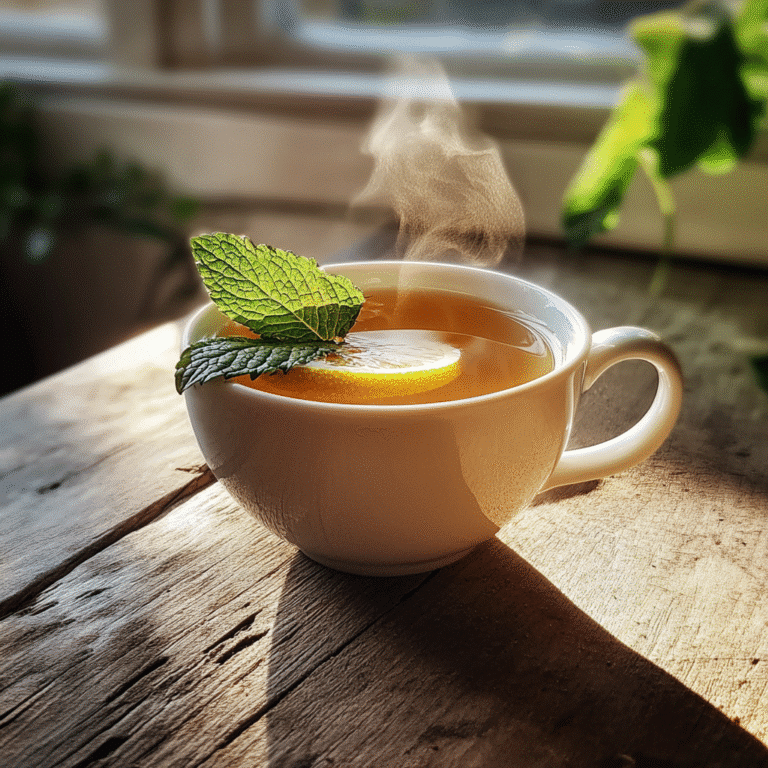
Lemon Balm Tea Recipe
5 Stars 4 Stars 3 Stars 2 Stars 1 Star
No reviews
A soothing herbal tea made from lemon balm leaves, known for its calming properties and gentle citrus-mint flavor—perfect for relaxation, digestion, and restful sleep.
- Total Time: 10 minutes
- Yield: 1 cup 1x
Ingredients
8–10 fresh lemon balm leaves (or 1 to 1½ tsp dried)
1 cup filtered water
Optional: raw honey
Optional: fresh lemon juice
Optional: ginger slices
Optional: chamomile or lavender flowers
Instructions
1. Rinse fresh lemon balm leaves under cold water if using fresh.
2. Tear or bruise the leaves slightly to release natural oils.
3. Place leaves (or dried lemon balm) into a teacup, teapot, or infuser.
4. Heat water to just below boiling (around 190°F–200°F).
5. Pour hot water over the lemon balm leaves.
6. Cover and steep for 7–10 minutes for fresh leaves or 5–7 minutes for dried.
7. Strain the tea and discard herbs.
8. Add honey, lemon, or other optional flavorings if desired.
9. Serve hot or pour over ice for a refreshing cold tea.
Notes
Fresh lemon balm gives a bright, citrusy flavor, while dried has a more concentrated earthy profile.
Store extra brewed tea in the fridge for up to 3 days—great for iced tea.
Try blending with herbs like chamomile, peppermint, or lavender for added benefits.
Avoid boiling water to preserve essential oils and avoid bitterness.
Consult a doctor before drinking regularly if you have thyroid conditions or take sedatives.
- Author: Jessica Lupone!
- Prep Time: 5 minutes
- Cook Time: 5 minutes
- Category: Drinks
- Method: Steeping
- Cuisine: Herbal
- Diet: Vegan
Nutrition
- Serving Size: 1 cup
- Calories: 2
- Sugar: 0
- Sodium: 1
- Fat: 0
- Saturated Fat: 0
- Unsaturated Fat: 0
- Trans Fat: 0
- Carbohydrates: 0
- Fiber: 0
- Protein: 0
- Cholesterol: 0
Health Benefits of Lemon Balm Tea Recipe
Natural Stress Relief and Sleep Aid
One of the main reasons people turn to lemon balm tea recipe is for its ability to calm the mind and body. Lemon balm contains natural compounds like rosmarinic acid and citral, which support the nervous system and help regulate mood.
Studies show that regular consumption of lemon balm tea recipe may:
- Reduce symptoms of anxiety and nervousness
- Improve overall sleep quality
- Lower restlessness and racing thoughts before bed
Drinking a warm cup of lemon balm tea recipe before bedtime acts as a gentle sleep tonic. It helps calm your thoughts without the grogginess associated with over-the-counter sleep aids.
Digestive Support and Immune Boost
Beyond its calming effects, lemon balm tea recipe is also known to promote healthy digestion. Thanks to its antispasmodic properties, lemon balm tea recipe can:
- Relieve gas and bloating
- Soothe upset stomachs
- Support regular bowel movements
It also has antiviral and antibacterial properties that can help the body naturally fight infections and strengthen immune defense.
Discover great ideas like Does Zepbound Need to Be Refrigerated? to complement your health-conscious choices.
By incorporating lemon balm tea into your routine, you’re not just indulging in a warm beverage—you’re fueling your wellness from the inside out.
Ingredients for a Perfect Lemon Balm Tea Recipe
Fresh vs. Dried Lemon Balm Tea Recipe: Which to Use
When it comes to brewing a delicious lemon balm tea recipe, you’ve got two great options: fresh or dried leaves. Each offers distinct benefits, so your choice ultimately comes down to what’s available and which flavor you prefer.
| Type | Flavor Profile | Best For |
|---|---|---|
| Fresh Leaves | Bright, citrusy, herbaceous | Daily home use, garden fresh |
| Dried Leaves | Earthy, concentrated aroma | Long-term storage, winter use |
Fresh lemon balm tea recipe provides a livelier aroma and is perfect for those who grow the herb at home. Just pick about 8–10 leaves per cup.
Dried lemon balm, on the other hand, is more convenient and shelf-stable. You’ll typically need 1–2 teaspoons per cup of hot water.
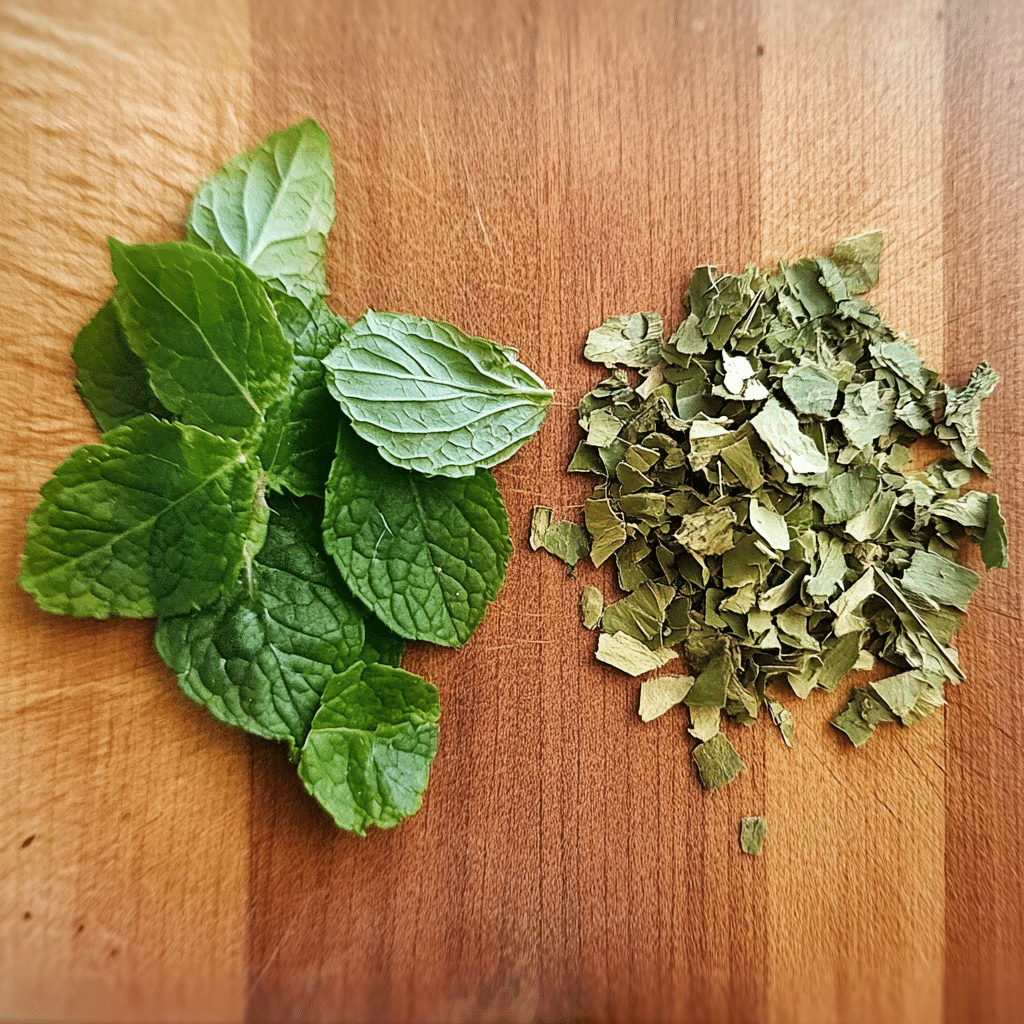
Optional Add-ins: Honey, Lemon, Ginger, and More
One of the best things about this lemon balm tea recipe is its versatility. While it’s delightful on its own, you can enhance the flavor and benefits with simple, wholesome ingredients:
- Raw honey: Adds natural sweetness and soothes the throat
- Fresh lemon juice: Boosts vitamin C and tanginess
- Ginger slices: Adds warmth and supports digestion
- Lavender: Pairs well for extra calming effect
- Chamomile flowers: A relaxing herbal blend
Experiment with combinations to match your needs—energizing in the morning, soothing before bed.
How to Make Lemon Balm Tea Recipe at Home
Step-by-Step Instructions (Fresh and Dried Versions)
Making a fresh cup of lemon balm tea recipe is simple and can be done in under 10 minutes. Whether you use fresh or dried leaves, the method is straightforward.
🔹 How to Make Lemon Balm Tea Recipe (Using Fresh Leaves)
Ingredients:
- 8–10 fresh lemon balm leaves
- 1 cup of filtered water
- Optional: honey, lemon, or ginger
Instructions:
- Rinse the lemon balm leaves under cold water.
- Tear or lightly bruise the leaves to release the oils.
- Place them in a teacup or teapot.
- Heat 1 cup of water until it’s just about to boil, but not vigorously bubbling.
- Pour water over the leaves.
- Cover and steep for 7–10 minutes.
- Strain, add sweeteners or citrus if desired, and enjoy.
🔹 How to Make Lemon Balm Tea Recipe (Using Dried Leaves)
Ingredients:
- 1 to 1½ teaspoons of dried lemon balm
- 1 cup hot water
Instructions:
- Add the dried lemon balm to a tea infuser or strainer.
- Pour boiling water over the tea.
- Let it steep for 5–7 minutes (dried herbs release flavor faster).
- Remove the strainer and serve hot.
✅ Tip: You can double or triple the quantities to make a larger batch and store in the fridge for a refreshing iced tea version.
Brew Time, Temperature, and Storage Tips
For optimal results, brew at 190°F–200°F (just below boiling) to preserve lemon balm’s beneficial oils. Avoid overboiling, which can cause bitterness.
If you make a big batch:
- Store in a sealed glass jar in the fridge for up to 3 days.
- Reheat gently or serve over ice with lemon slices.
Don’t miss our Blue Salt for Men for more natural drink ideas to add to your routine.
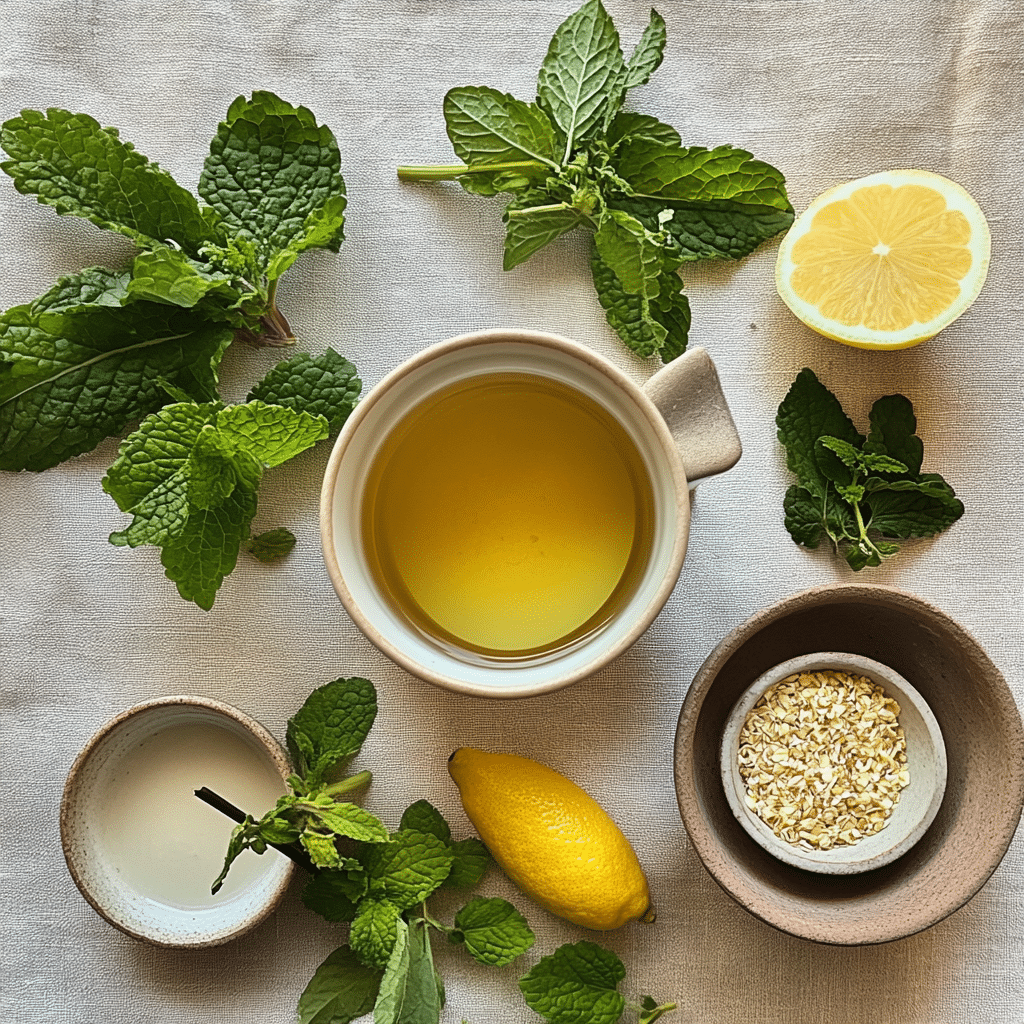
Customizing Your Lemon Balm Tea Recipe
Making It Iced, Sugar-Free, or Flavored
One of the best things about this lemon balm tea recipe is how easily you can make it your own. Depending on your dietary needs or flavor preferences, you can enjoy this tea hot, cold, or naturally sweetened.
🧊 Iced Lemon Balm Tea Recipe
To enjoy a refreshing, chilled version:
- Brew a stronger batch (double the leaves).
- Let it cool completely.
- Pour over ice and garnish with lemon slices or fresh mint leaves.
🍯 Sugar-Free Lemon Balm Tea Recipe
Watching your sugar intake? No problem. This tea is naturally light and doesn’t require sugar. However, if you want a hint of sweetness without the calories:
- Use stevia, monk fruit, or erythritol.
- Add cinnamon stick while steeping to naturally enhance flavor.
🍋 Flavor Variations to Try
Try these pairings to give your tea new life:
- Lemon + Honey + Ginger: For cold relief
- Chamomile + Lavender: Ultimate relaxation blend
- Peppermint + Lemon Balm: Refreshing digestive tonic
These additions not only make it tastier but boost its health benefits. You can create a rotation of tea blends for every season or mood.
Pairing It With Other Herbs Like Chamomile or Mint
Lemon balm blends beautifully with other herbs, making it a staple in DIY herbal infusions. Here’s a quick guide:
| Herb | Benefits | Flavor Profile |
|---|---|---|
| Chamomile | Enhances relaxation, sleep support | Floral, smooth |
| Peppermint | Aids digestion, clears sinuses | Minty, cool |
| Lavender | Calms nervous system, eases tension | Sweet, perfumed |
| Ginger | Anti-inflammatory, supports circulation | Spicy, warm |
Check out Cottage Cheese Banana Bread again—it’s a perfect companion to any of these blends.
When and How to Drink Lemon Balm Tea Recipe
Best Times of Day to Drink It
The beauty of this lemon balm tea recipe lies in its flexibility. You can enjoy it morning, noon, or night—but the best time depends on your goal.
| Time of Day | Best Use | Why It Works |
|---|---|---|
| Morning | Calm your nerves before a busy day | Gentle energizer without caffeine |
| Afternoon | Ease digestive discomfort after lunch | Soothes bloating and stress |
| Evening | Wind down and sleep better | Supports relaxation and better sleep |
For many, drinking a warm cup an hour before bedtime becomes a cherished ritual. It signals the brain and body that it’s time to relax.
How Often You Can Safely Enjoy It
You can drink lemon balm tea daily, but moderation is key—especially if you’re combining it with other calming herbs.
Recommended safe consumption:
- 1 to 3 cups per day
- Rotate with other herbal teas if you drink multiple cups daily
- Take occasional breaks (1–2 days per week) if drinking long-term
It’s also smart to start slow. Try 1 cup per day and assess how your body responds before increasing.
If you’re ever unsure, consult a healthcare provider, especially if you’re managing a medical condition or taking medications.
Discover great ideas like Does Zepbound Need to Be Refrigerated? to maintain your wellness routine.
Who Should Avoid Lemon Balm Tea Recipe
Cautions for People With Thyroid Issues or Other Conditions
While this lemon balm tea recipe is safe for most people, there are specific health situations where caution is advised.
One of the most well-known precautions involves the thyroid. Lemon balm may interfere with thyroid hormone production, particularly in those with hypothyroidism or Hashimoto’s disease.
Avoid or limit lemon balm tea if you:
- Have a diagnosed thyroid condition (unless approved by your doctor)
- Are taking thyroid medications like levothyroxine
- Experience fatigue or brain fog that worsens with consumption
Additionally, people with glaucoma or those taking sedatives, barbiturates, or anti-anxiety medications should consult their physician before drinking lemon balm tea, as it may enhance the effects of these drugs.
Interactions With Medications
Lemon balm interacts with various medications due to its mild sedative properties and its ability to impact enzymes in the liver.
Here are a few medication categories that might conflict:
- Thyroid hormones
- Benzodiazepines (e.g., Valium, Xanax)
- Anti-seizure drugs
- HIV medications
- Blood thinners
Always check with a medical provider before starting daily use of lemon balm if you are:
- Pregnant or breastfeeding
- Taking prescribed medication
- Undergoing surgery (stop at least 2 weeks before)
Even natural teas can have powerful effects—especially when consumed regularly. If you’re unsure, a simple call to your healthcare provider goes a long way.
Don’t miss our Blue Salt for Men for another targeted wellness drink crafted with safety in mind.
Traditional Uses and Folklore Around Lemon Balm Tea Recipe
Lemon Balm in Ancient Herbal Medicine
Lemon balm isn’t just a trendy herb in modern wellness circles—it’s been valued for over 2,000 years. Known historically as “the elixir of life,” lemon balm was widely used in traditional medicine across cultures.
In ancient Greece and Rome, it was prescribed by physicians like Dioscorides and Hippocrates for:
- Calming the heart
- Relieving anxiety and melancholy
- Supporting digestion and liver function
The famous Swiss physician Paracelsus called it the “plant that revives the spirit,” and used it in tinctures to promote longevity and emotional balance.
In European monasteries, lemon balm was a core ingredient in herbal remedies, tonics, and even liquors like Carmelite water—a calming tonic still made today.
Cultural Beliefs and Modern Interpretations
Lemon balm’s uplifting, lemony scent has always been linked to purification, peace, and joy. In medieval times, it was used to anoint homes and temples as a symbol of harmony.
Some folklore beliefs included:
- Planting lemon balm near a home brought love and good fortune
- Drinking lemon balm tea kept nightmares away
- Carrying dried leaves protected travelers on long journeys
In modern times, lemon balm continues to be viewed as a herbal ally for the heart and mind, used by herbalists and naturopaths to bring balance and ease.
This deep-rooted heritage adds a layer of comfort to every sip. When you make this lemon balm tea recipe, you’re not just brewing a drink—you’re connecting with centuries of wisdom.
Sustainability and Growing Your Own Lemon Balm Tea Recipe
Tips for Growing Lemon Balm at Home
Want to make this lemon balm tea recipe even more rewarding? Grow the herb yourself! Lemon balm is one of the easiest perennials to grow at home, whether in a pot or garden bed.
Here’s how to get started:
- Light: Prefers full sun to partial shade
- Soil: Well-drained with compost or organic matter
- Water: Keep soil moist but not soggy
- Spacing: Plant 12–18 inches apart if growing in beds
- Harvesting: Start picking leaves when the plant is 6–8 inches tall
Bonus: Lemon balm is a pollinator magnet, drawing in bees and butterflies, while also helping to repel mosquitoes—making it a valuable addition to any garden.
Drying, Storing, and Using Your Own Herbs
If you grow your own, you can easily dry the leaves for year-round tea:
How to Dry Lemon Balm:
- Harvest in the morning after dew has dried
- Tie stems in small bundles and hang upside-down in a cool, dark area
- Once leaves are crisp, remove and store in airtight glass jars
Storage Tips:
- Keep away from light and moisture
- Label with harvest date
- Use within 6–12 months for best flavor
By growing and preserving your own lemon balm, you not only save money but gain complete control over your tea’s quality and freshness. It’s a sustainable and satisfying practice that connects you back to the earth and your health.
Check out Cottage Cheese Banana Bread again—it pairs beautifully with your homegrown herbal brews.
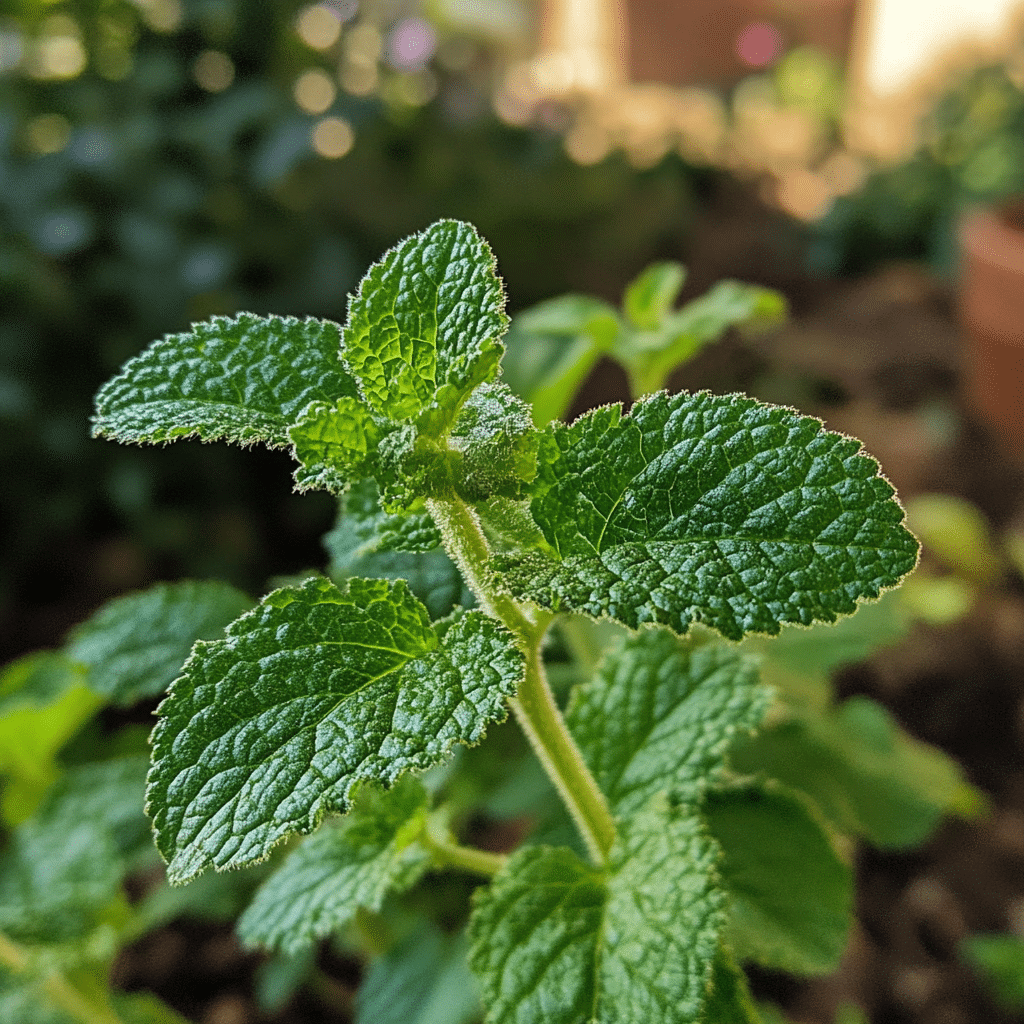
Conclusion: Sip Calmly, Sip Often
If you’re seeking a gentle herbal tea that brings peace of mind, supports digestion, and helps with sleep, this lemon balm tea recipe is your new best friend. It’s easy to prepare, highly customizable, and deeply rooted in centuries of herbal wisdom.
Whether you’re using fresh leaves from your garden or dried herbs from your pantry, this tea is a natural, caffeine-free way to support your wellness—and slow down a little in a fast-paced world.
Looking for more natural drink ideas? Don’t miss our Blue Salt for Men and related recipes to enhance your daily routine.
For more recipes Follow me in our Social media
Facebook: https://www.facebook.com/profile.php?id=61573913076847
Pinterest: https://www.pinterest.com/momandgrandmacooks/
Medium: https://medium.com/@momandgrandmacooks
Frequently Asked Questions About Lemon Balm Tea Recipe
Can I drink this every day?
Yes, you can drink lemon balm tea daily—many people do! Just stick to 1–3 cups per day, and consider taking a short break every few weeks to let your body reset. If you have thyroid issues or are on medications, talk to your doctor before regular use.
Can I use dried lemon balm?
Absolutely. Dried lemon balm is a convenient and effective option for making tea. It has a slightly deeper, earthy taste than fresh leaves. Just use 1 to 1½ teaspoons per cup of water and steep for 5–7 minutes.
Is this drink safe for people with health conditions?
In general, lemon balm is gentle and well-tolerated. However, it may interact with:
Thyroid medication
Sedatives or anti-anxiety drugs
HIV medications or blood thinners
If you’re pregnant, nursing, or managing a chronic illness, consult your doctor before adding lemon balm tea to your daily routine.
Can I make this drink sugar-free?
Yes! In fact, the basic lemon balm tea recipe is naturally sugar-free. If you want sweetness, use stevia, monk fruit, or erythritol instead of honey or sugar. Cinnamon sticks and lemon can also add a sweet flavor without adding calories.
Can I drink lemon balm tea on an empty stomach?
Yes, it’s usually safe to drink on an empty stomach. Many people sip a cup first thing in the morning to ease into their day with calm energy. If you notice any mild stomach upset, pair it with a light snack.

